Drones can reveal breathtaking perspectives and vital details about extreme sports adventures. They'll give you bird's-eye views of remote landscapes, capturing the full scope of challenging terrains. You'll see high-speed action sequences from unique angles, whether it's tracking snowboarders down steep slopes or following wingsuit flyers through narrow gaps. Drones enhance safety by scouting routes, identifying hazards, and monitoring weather conditions. They'll help map mountain bike trails, explore hidden surf spots, and document cliff diving with unparalleled precision. From BASE jumping to extreme kayaking, drones offer insights into athlete techniques and environmental challenges. The aerial revolution in extreme sports is just taking off.
Aerial Perspectives of Extreme Landscapes
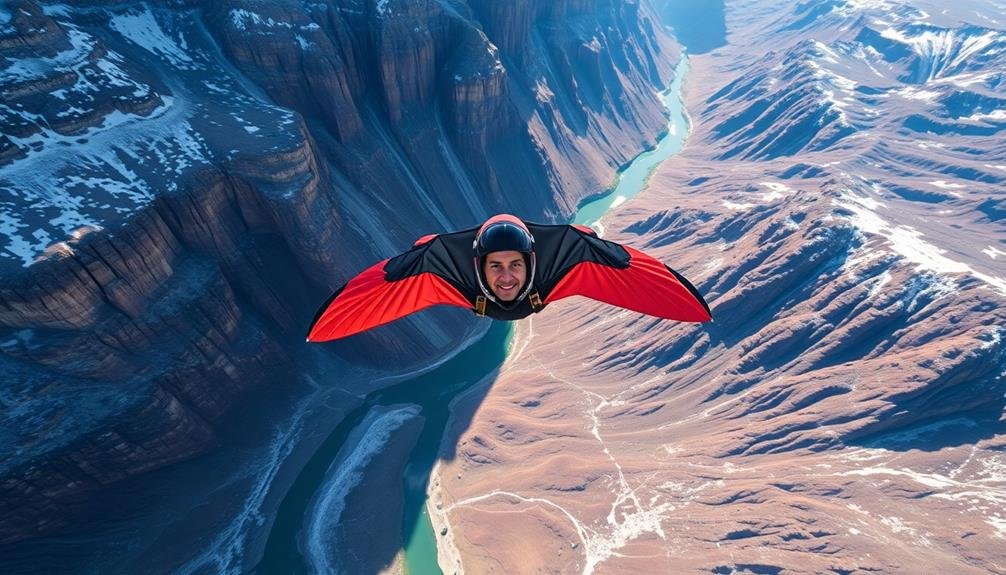
Three key aspects make drones invaluable for capturing aerial perspectives of extreme landscapes.
First, they provide unparalleled access to remote and dangerous terrain. You'll be able to scout locations, plan routes, and assess risks without putting yourself in harm's way. Drones can reach vantage points that would be impossible or extremely risky for humans, giving you a thorough view of the landscape.
Second, drones offer dynamic and immersive footage. You can capture sweeping panoramas, follow athletes through challenging courses, and showcase the scale of extreme environments. This bird's-eye view adds depth and context to your adventures, allowing viewers to truly appreciate the magnitude of the challenges you face.
Lastly, drones enable real-time monitoring and decision-making. You can use them to track weather patterns, assess snow conditions, or monitor ocean swells. This up-to-the-minute information helps you make informed choices about when and where to pursue your extreme sports activities, enhancing both safety and performance.
With drones, you'll gain a new perspective on the landscapes you conquer, elevating your extreme sports experience to new heights.
Capturing High-Speed Action Sequences
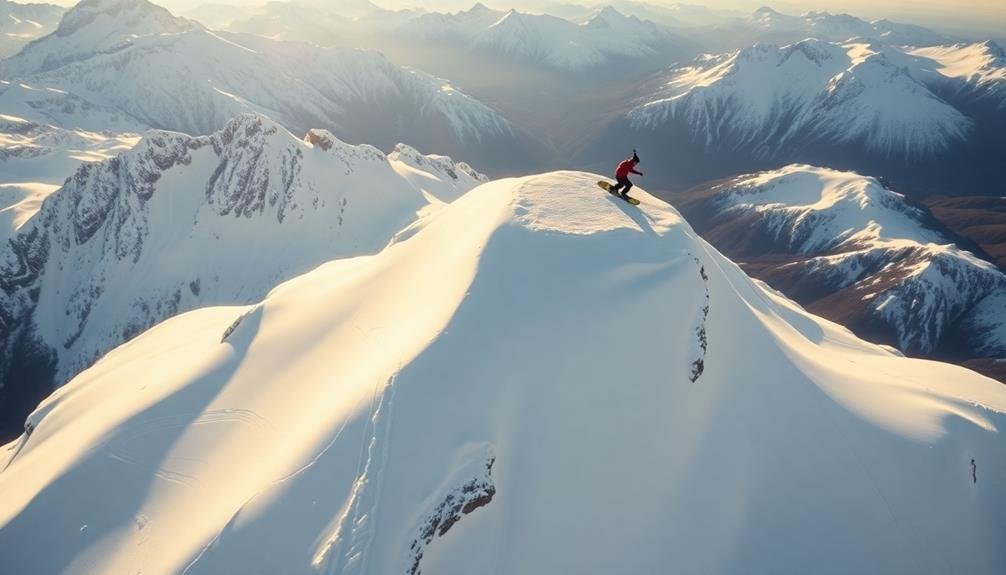
You'll be amazed at how drones can capture high-speed action sequences in extreme sports.
With their ability to freeze-frame mid-air maneuvers, you'll get stunning shots of athletes at the peak of their performance.
Drones excel at tracking dynamic motion paths and providing multi-angle simultaneous footage, giving you an extensive view of the action that was previously impossible to achieve.
Freeze-Frame Mid-Air Maneuvers
Capturing freeze-frame mid-air maneuvers with drones has revolutionized extreme sports photography. You can now freeze athletes in mid-flight, revealing intricate details of their tricks that were previously impossible to capture. Drones equipped with high-speed cameras allow you to shoot at frame rates up to 1000 fps, ensuring crystal-clear images of even the fastest movements.
To capture these jaw-dropping shots, you'll need to master precise drone control and timing. Position your drone at the ideal angle and distance from the action, anticipating the athlete's trajectory. Use burst mode or pre-programmed flight paths to increase your chances of nailing the perfect moment.
You'll want to experiment with different shutter speeds to find the right balance between freezing motion and maintaining some sense of movement in the image.
Post-processing plays a vital role in bringing out the best in your freeze-frame shots. You can enhance contrast, adjust colors, and even combine multiple exposures to create stunning composite images that showcase the entire sequence of a mid-air maneuver.
With practice, you'll be able to produce breathtaking visuals that reveal the true artistry of extreme sports.
Tracking Dynamic Motion Paths
Dynamic motion tracking with drones opens up a whole new world of possibilities for capturing high-speed action sequences in extreme sports. You'll witness the fluid movements of athletes as they navigate challenging terrains or perform death-defying stunts.
Drones equipped with advanced tracking technology can follow subjects with pinpoint accuracy, maintaining smooth footage even in the most chaotic environments.
You're no longer limited to static shots or pre-planned routes. With dynamic motion tracking, you can:
- Capture seamless follow-shots of snowboarders carving down steep slopes
- Record the intricate flight paths of wingsuit flyers as they soar through canyons
- Track surfers riding massive waves from multiple angles simultaneously
These capabilities allow you to tell more compelling visual stories and provide viewers with a truly immersive experience.
You'll be able to showcase the speed, precision, and skill of extreme athletes in ways that were previously impossible. By analyzing the footage, you can gain valuable insights into technique, form, and strategy.
This technology not only revolutionizes how we document extreme sports but also how we study and improve performance in these high-stakes disciplines.
Multi-Angle Simultaneous Footage
Several drones working in unison can revolutionize how we capture high-speed action sequences in extreme sports.
You'll witness a new level of immersion as multiple drones simultaneously track athletes from various angles. This multi-angle approach allows you to experience the action from perspectives that were previously impossible to achieve.
With synchronized drones, you'll see a snowboarder's aerial maneuver from above, below, and alongside simultaneously. You can follow a mountain biker's descent through treacherous terrain from both front and rear views, capturing every twist and turn.
These multi-angle shots provide a thorough understanding of the athlete's technique and the environment they're traversing.
You'll appreciate the seamless shifts between drone footage, creating a dynamic and engaging viewing experience. This technique also enhances slow-motion replays, allowing you to analyze intricate movements from multiple vantage points.
As a viewer, you'll gain a deeper appreciation for the skill and precision required in extreme sports.
Multi-angle simultaneous footage isn't just about capturing the action; it's about telling a more complete story.
You'll see the athlete's expression, their body positioning, and the surrounding landscape all at once, providing a truly immersive experience.
Unique Angles for Cliff Diving

Drones offer three game-changing angles for cliff diving footage that were once impossible to achieve. You'll be amazed at how these unique perspectives can transform your viewing experience and provide a deeper understanding of the sport's complexity.
First, drones can capture the diver's descent from directly above, following their path from the cliff's edge to the water's surface. This bird's-eye view allows you to witness the precise moment of takeoff and track the diver's trajectory throughout the entire jump.
Next, drones can hover at eye level with the cliff's edge, providing a side-on view of the diver's approach and initial leap. This angle showcases the athlete's technique and the immense height they're conquering.
Lastly, drones can capture underwater shots as the diver enters the water, revealing the splash pattern and the diver's submersion. This perspective highlights the impact and completes the visual story of the dive.
These unique angles offer several benefits:
- Enhanced safety monitoring for athletes and event organizers
- Improved analysis of diving techniques for coaches and competitors
- Increased audience engagement through immersive, cinematic footage
Tracking Snowboarders Through Mountain Terrain
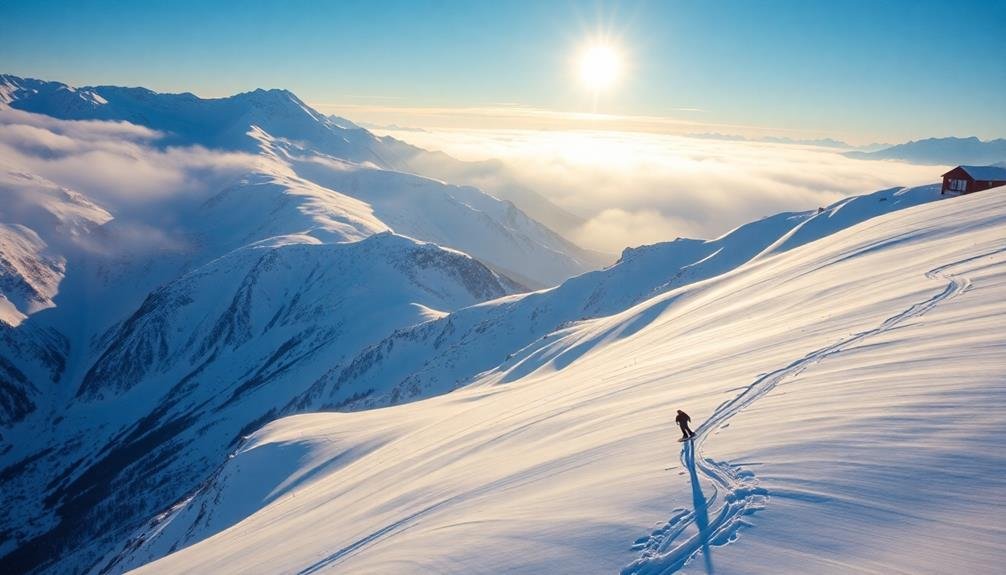
You'll find drones revolutionizing snowboarding adventures by providing aerial route mapping capabilities.
As you carve through mountain terrain, these flying cameras can scout ahead, identifying potential hazards and ideal paths.
They're also proving invaluable for detecting avalanche risks, giving you essential safety information before you tackle challenging slopes.
Aerial Route Mapping
As snowboarders carve their way through treacherous mountain terrain, drones have emerged as invaluable tools for aerial route mapping. You'll find these flying machines hovering above, capturing detailed imagery of the landscape below. They're not just for show; they're providing essential information to help you navigate the slopes safely and efficiently.
With drones, you can:
- Scout potential routes before setting out
- Identify hazards like avalanche-prone areas or hidden crevasses
- Discover new, unexplored lines for more thrilling descents
You'll appreciate the bird's-eye view that drones offer, giving you an all-encompassing understanding of the mountain's topography. They can quickly survey vast areas, allowing you to plan your route with precision.
You'll be able to spot natural features like ridges, bowls, and chutes that mightn't be visible from the ground.
Moreover, drones can help you assess snow conditions across different elevations and aspects. This information is critical for making informed decisions about where to ride and which areas to avoid.
Detecting Avalanche Risks
Beyond route mapping, drones play an essential role in detecting avalanche risks and tracking snowboarders through treacherous mountain terrain. You'll find these unmanned aerial vehicles equipped with specialized sensors and cameras that can identify potential avalanche zones. They'll scan the snowpack, detecting weak layers and unstable areas that mightn't be visible to the naked eye.
As you venture into backcountry terrain, drones can monitor your progress and alert rescue teams if you're in danger. They'll use thermal imaging to locate you in case of an emergency, even in low-visibility conditions. You'll appreciate how drones can quickly survey large areas, providing real-time data on snow conditions and potential hazards.
Drones also help you plan safer routes by identifying cornices, crevasses, and other obstacles. They'll transmit this information to your GPS device, allowing you to make informed decisions about your descent.
You'll benefit from their ability to assess the stability of different slopes, helping you avoid high-risk areas. With drones watching over you, you'll have an extra layer of safety as you pursue your extreme snowboarding adventures in challenging mountain environments.
Following Wingsuit Flyers Mid-Flight
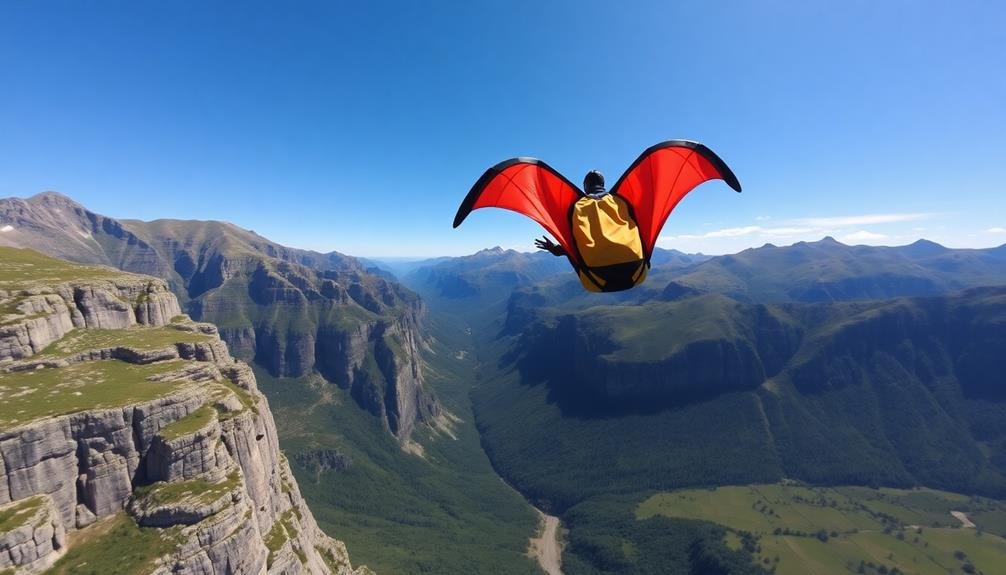
During wingsuit flights, drones have revolutionized the way we capture these death-defying adventures. You'll find that drones can keep pace with wingsuit flyers, offering unique perspectives and stunning footage that was previously impossible to obtain. They're able to follow flyers through narrow gaps, around obstacles, and even alongside sheer cliff faces.
As you plan your wingsuit filming expedition, consider these key advantages of using drones:
- Versatility: Drones can quickly adjust their position and altitude to capture the best angles.
- Safety: They eliminate the need for camera operators to put themselves in dangerous positions.
- Cost-effectiveness: Drones are more affordable than helicopters for aerial filming.
You'll need to coordinate closely with your drone pilot to guarantee smooth footage and maintain safety. It's essential to brief them on your planned route and any potential hazards.
Remember that weather conditions can greatly impact both wingsuit and drone performance, so always check forecasts before your flight.
Revealing Hidden Surfing Spots

Discovering secret surf spots has never been easier thanks to drone technology. You can now scout remote coastlines and hidden beaches from the air, uncovering perfect waves that were previously inaccessible or unknown. Drones allow you to assess wave quality, crowd levels, and potential hazards before committing to a long trek or boat ride.
With a drone, you'll gain valuable insights into:
| Aspect | Benefit | Example |
|---|---|---|
| Wave Conditions | Assess size and consistency | Spot offshore wind effects |
| Beach Access | Identify entry/exit points | Discover hidden coves |
| Safety | Spot rip currents and rocks | Avoid dangerous surf zones |
Documenting Rock Climbing Routes
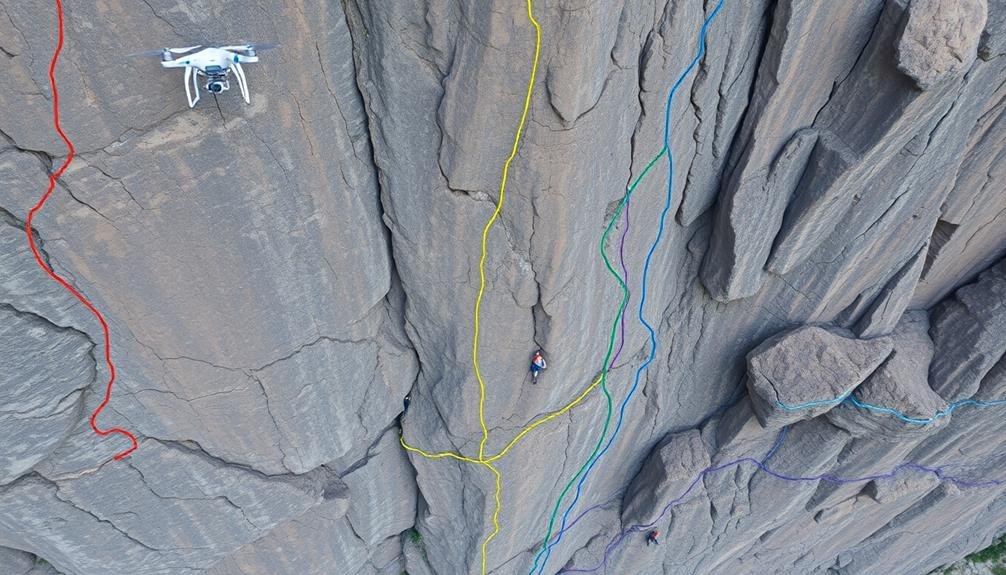
Drones have revolutionized the way rock climbers document and share their routes. You can now capture stunning aerial footage of climbs that were previously impossible to film. With a drone, you're able to scout potential routes, assess their difficulty, and plan your ascent before even touching the rock face.
These flying cameras offer unique perspectives that allow you to:
- Analyze the intricacies of a climb from multiple angles
- Spot hidden holds and features that might be missed from the ground
- Create detailed 3D models of rock formations for training and route planning
You'll find that drones are particularly useful for documenting first ascents and exploring remote climbing areas. They can help you map out new routes and share them with the climbing community, fostering a spirit of exploration and adventure.
When you're filming your climbs with a drone, you'll be able to capture your entire journey, from the base to the summit. This thorough footage not only serves as a personal record but also provides valuable information for other climbers who might attempt the same route in the future.
Showcasing Extreme Kayaking Adventures
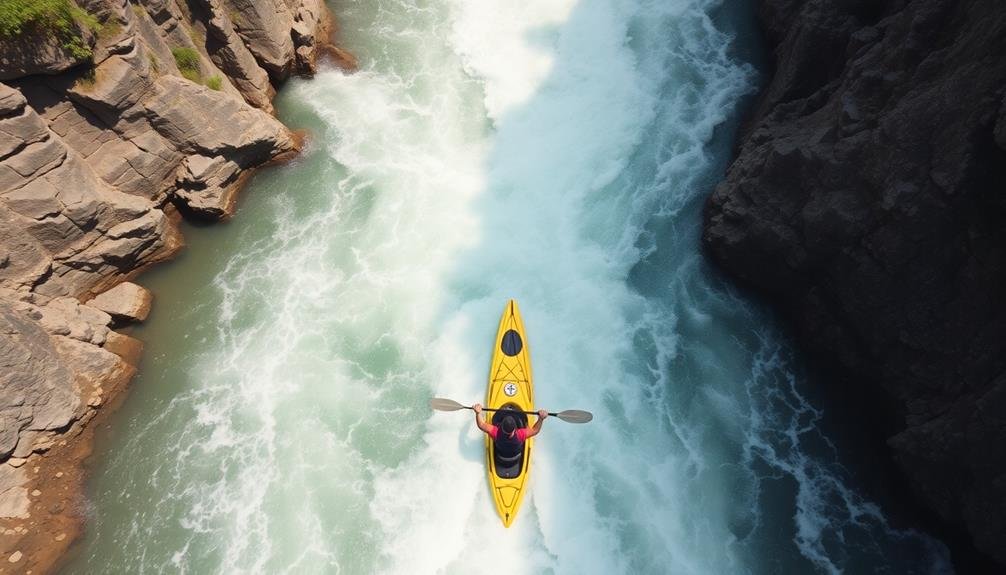
You'll be amazed by the breathtaking aerial footage of kayakers dropping into remote rivers, captured by strategically positioned drones.
These unmanned aircraft can follow kayakers through treacherous whitewater rapids, providing a unique perspective that was previously impossible to achieve.
With drones, you're able to witness the full scope of extreme kayaking adventures, from the initial plunge to the final triumph over nature's aquatic obstacles.
Aerial Kayak Drop Footage
Plummeting from dizzying heights, extreme kayakers have found a new way to push their limits with aerial kayak drops. Drones capture these heart-stopping moments, giving you a bird's-eye view of the action. You'll witness kayakers being released from helicopters or clifftops, free-falling through the air before splashing into raging rivers or pristine lakes below.
Drone footage reveals the intricate details of these death-defying stunts:
- The kayaker's technique as they position themselves mid-air
- The precise moment of impact with the water's surface
- The kayaker's recovery and navigation of turbulent waters post-drop
You'll gain a new appreciation for the skill and bravery required in these extreme sports. Drones allow you to see the entire sequence unfold, from the initial drop to the kayaker's emergence downstream.
The aerial perspective highlights the surrounding landscape, showcasing the remote and treacherous locations these thrill-seekers choose for their adventures.
As you watch the footage, you'll feel your heart race, experiencing the adrenaline rush vicariously through the screen. Aerial kayak drop footage brings you closer to the action than ever before, revealing the true intensity of this extreme sport.
Whitewater Rapids Perspective
From the churning waters below, drones capture the heart-pounding excitement of whitewater kayaking. You'll witness kayakers traversing treacherous rapids, their skills put to the test as they maneuver through foaming whitewater and jagged rocks. Drones provide a unique perspective, offering views that were once impossible to achieve.
You'll see the kayakers' expressions as they face each challenge, their determination palpable as they conquer one rapid after another. The drone footage reveals the raw power of the river, showcasing the sheer force of nature that these adventurers must overcome.
| Emotion | Kayaker's View | Drone's View |
|---|---|---|
| Thrill | Limited | Panoramic |
| Fear | Intense | Detached |
| Triumph | Personal | Cinematic |
As you watch the footage, you'll gain a newfound appreciation for the sport's complexity. Drones capture the intricate dance between kayaker and water, revealing the precise timing and skill required to traverse each rapid successfully. You'll see how kayakers read the river, anticipating obstacles and adjusting their course in split-second decisions. This bird's-eye view offers invaluable insights for both enthusiasts and professionals alike.
Enhancing BASE Jumping Footage
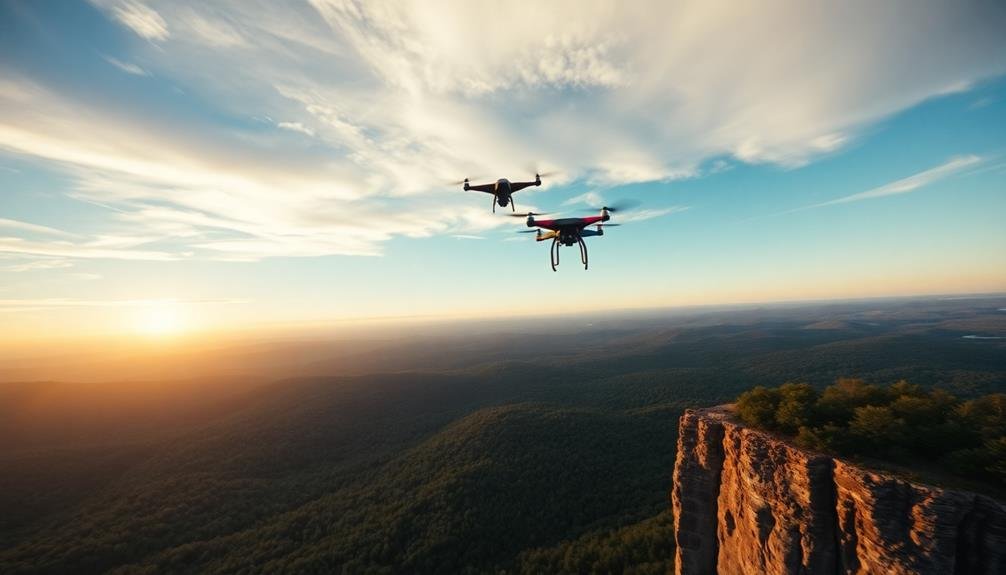
Three key elements make drones invaluable for enhancing BASE jumping footage: perspective, tracking, and safety.
You'll capture breathtaking aerial views that were once impossible, offering viewers a complete picture of the jump's scale and intensity. Drones can follow jumpers from launch to landing, providing seamless footage that puts the audience right in the action.
Safety is paramount in BASE jumping, and drones play an essential role. They can:
- Scout landing zones for potential hazards
- Monitor weather conditions in real-time
- Assist in search and rescue operations if needed
You'll find that drones elevate your BASE jumping videos to new heights, quite literally. They allow you to showcase the entire journey, from the anticipation at the jump point to the exhilaration of free fall and the precision of landing.
With drones, you can capture angles that convey the true risk and skill involved in the sport.
Mapping Challenging Mountain Bike Trails

While drones excel at capturing aerial footage of extreme sports, they're also game-changers for mountain biking enthusiasts. You can now use drones to map challenging trails before you even hop on your bike. These aerial scouts provide valuable information about trail conditions, obstacles, and potential hazards.
By flying a drone over your intended route, you'll get a bird's-eye view of the terrain. This allows you to plan your ride more effectively, anticipate difficult sections, and even discover hidden shortcuts. Here's a comparison of traditional trail mapping versus drone-assisted mapping:
| Aspect | Traditional Mapping | Drone-Assisted Mapping |
|---|---|---|
| Time | Time-consuming | Quick and efficient |
| Accuracy | Limited by ground view | Highly accurate aerial view |
| Safety | Potential risks | Safer reconnaissance |
| Cost | Labor-intensive | Cost-effective |
| Coverage | Limited to accessible areas | Can cover remote areas |
With drone-mapped trails, you'll ride with confidence, knowing what lies ahead. You can identify technical sections, drops, and jumps beforehand, allowing you to prepare mentally and physically for the challenges. This technology not only enhances your riding experience but also improves safety by helping you avoid unexpected obstacles or dangerous terrain.
Exploring Remote Extreme Sports Locations
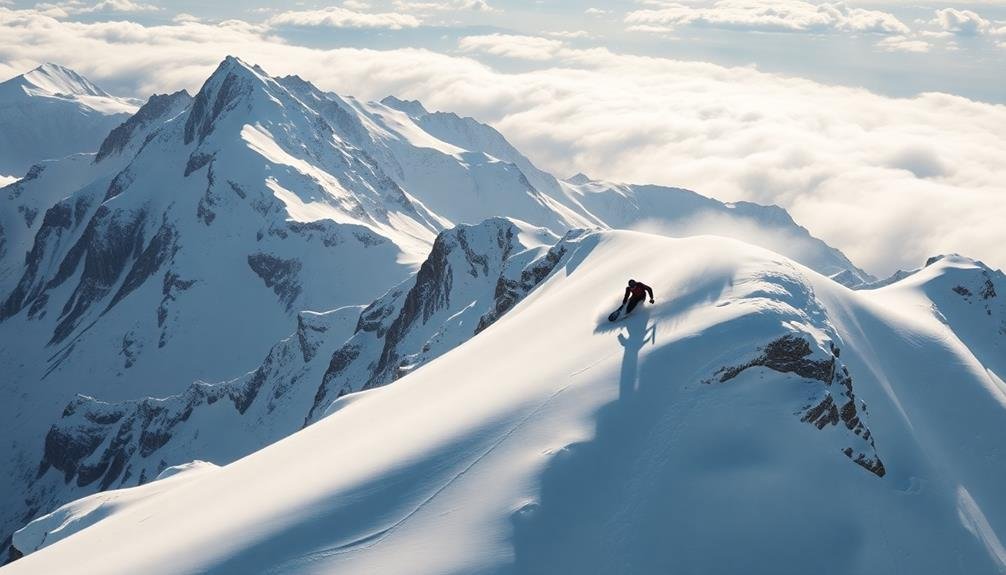
Adventurers are constantly seeking new, untamed locations for their extreme sports pursuits. Drones have become invaluable tools in this quest, allowing you to scout remote areas without risking life and limb. You can use these aerial explorers to identify potential sites for activities like base jumping, free climbing, or backcountry skiing.
With a drone, you'll gain a bird's-eye view of the terrain, helping you:
- Assess the difficulty and safety of potential routes
- Spot hidden dangers like unstable rock formations or crevasses
- Identify ideal landing zones for parachutes or emergency extractions
You can also use drones to create detailed 3D maps of unexplored regions, giving you essential information about elevation changes, water sources, and natural obstacles. This data allows you to plan your expedition more effectively, ensuring you're prepared for the challenges ahead.
Moreover, drones can help you discover hidden gems that might otherwise go unnoticed. You could stumble upon a perfect big wave surfing spot, an untouched powder bowl for snowboarding, or a pristine cliff face for rock climbing.
Frequently Asked Questions
How Do Extreme Sports Athletes and Drone Operators Coordinate Their Movements?
You'll need precise planning and communication. You'll coordinate timing, flight paths, and athlete routes. You'll use hand signals, radios, or pre-arranged cues. You'll practice together to sync movements and capture the best shots safely.
What Legal Restrictions Apply to Using Drones for Extreme Sports Filming?
You'll need to follow local drone laws, including registration, altitude limits, and no-fly zones. You can't fly over people or moving vehicles. Always get permission from property owners and keep your drone in sight.
How Do Weather Conditions Affect Drone Performance During Extreme Sports Shoots?
You'll find that wind, rain, and extreme temperatures greatly impact your drone's flight time, stability, and video quality. Cold weather drains batteries faster, while strong winds can make maneuvering tricky. Always check conditions before flying.
What Safety Precautions Are Taken When Flying Drones Near Extreme Sports Athletes?
You'll need to maintain a safe distance, use obstacle avoidance systems, and communicate with athletes. It's essential to follow local regulations, have spotters, and plan flight paths carefully. Always prioritize safety over getting the perfect shot.
How Has Drone Technology Improved the Analysis of Extreme Sports Techniques?
You'll find that drones have revolutionized technique analysis in extreme sports. They provide unique aerial views, allowing you to capture and study movements in detail. You can now break down complex maneuvers frame-by-frame, enhancing training and performance.
In Summary
You've seen how drones are revolutionizing extreme sports coverage. They're giving you unprecedented views of daring feats and treacherous terrain. From soaring alongside wingsuit flyers to mapping intricate mountain bike trails, drones are capturing the essence of adventure like never before. They're enhancing your understanding of these sports and bringing you closer to the action. As drone technology advances, you'll continue to experience extreme sports in exciting new ways, fueling your passion for adventure.

As educators and advocates for responsible drone use, we’re committed to sharing our knowledge and expertise with aspiring aerial photographers.
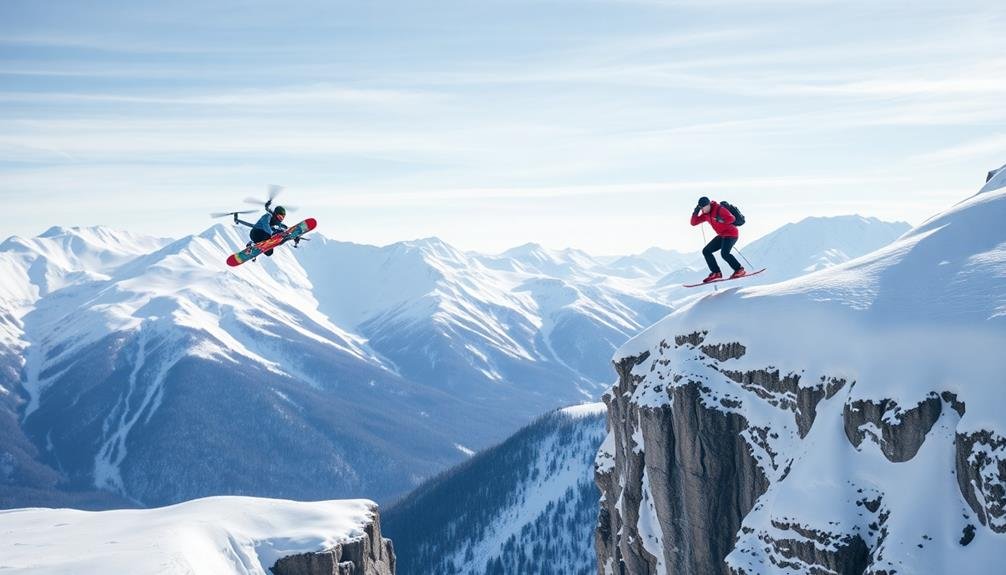


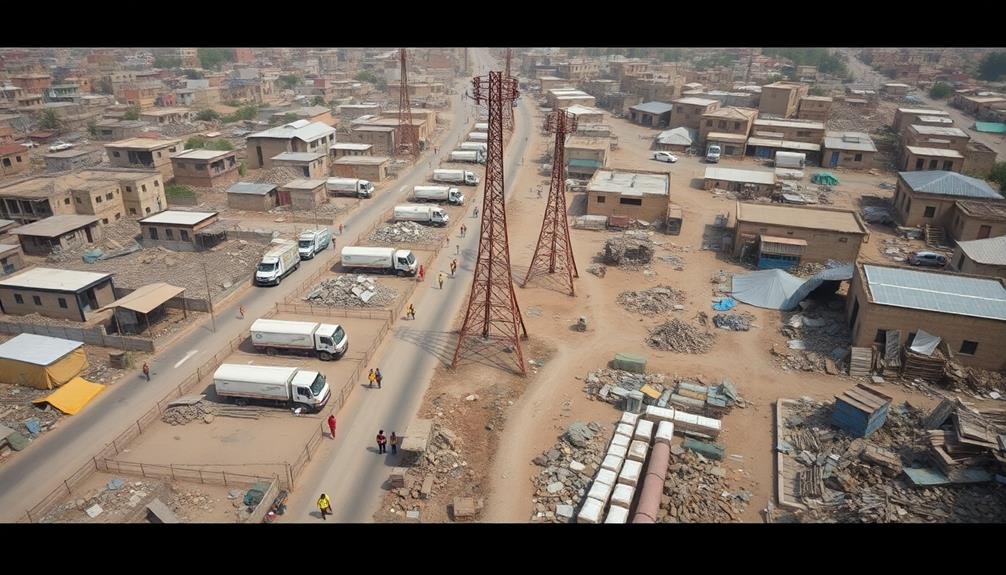
Leave a Reply